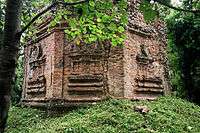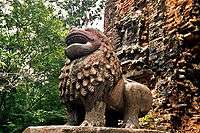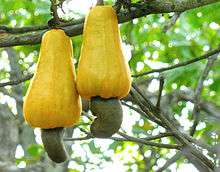Kampong Thom Province
| Kampong Thom ខេត្តកំពង់ធំ | |
|---|---|
| Province | |
|
Phnom Santuk | |
 Map of Cambodia highlighting Kampong Thom | |
| Coordinates: 12°42′N 104°53′E / 12.700°N 104.883°ECoordinates: 12°42′N 104°53′E / 12.700°N 104.883°E | |
| Country |
|
| Provincial status | 1907 |
| Capital | Stueng Saen |
| Government | |
| • Governor | Uth Sam An (CPP) |
| Area | |
| • Total | 13,814 km2 (5,334 sq mi) |
| Area rank | Ranked 2nd |
| Population (2009)[1] | |
| • Total | 708,398 |
| • Rank | Ranked 11th |
| • Density | 51/km2 (130/sq mi) |
| • Density rank | Ranked 17th |
| Time zone | UTC+07 |
| Dialing code | +855 |
| ISO 3166 code | KH-6 |
| Districts | 8 |
Kampong Thom (Khmer: កំពង់ធំ, IPA: [kɑmpɔːŋ tʰom] "Grand Port") is a province (khaet) of Cambodia. It borders the provinces of Siem Reap to the northwest, Preah Vihear to the north, Stung Treng to the northeast, Kratie to the east, Kampong Cham, Kampong Chhnang to the south, and the Tonle Sap to the west.
The provincial capital is Stung Saen, a town of approximately 30,000 people on the banks of the Stung Sen River.
Kampong Thom is Cambodia's second largest province by area. There are a number of significant Angkorian sites in the area, including Prasat Sambor Prei Kuk and Prasat Andet temples. As one of the nine provinces bordering Tonle Sap Lake, Kampong Thom is part of the Tonlé Sap Biosphere Reserve.[2]
People
- Eng Chhai Eang, politician
- Kang Kek Iew, former Khmer Rouge personnel
- Ke Pauk, former Khmer Rouge personnel
- Kouch Sokumpheak, footballer
- Nguon Nhel, politician
- Pol Pot, former Khmer Rouge dictator and Prime Minister
Administration


The province is subdivided into 8 districts.
- 0601 Barayបារ៉ាយ
- 0602 Kampong Svay កំពង់ស្វាយ
- 0603 Stueng Saenស្ទឹងសែន
- 0604 Prasat Ballangk ប្រាសាទបល្ល័ង
- 0605 Prasat Sambour ប្រាសាទសំបួរ
- 0606 Sandanសណ្ដាន់
- 0607 Santukសន្ធុក
- 0608 Stoungស្ទោង
History
The previous name of the province was Kampong Pous Thom (Port/City of the Great Snakes). According to local legend, at a lakeside dock near the Sen River, a pair of large snakes inhabited a nearby cave. On every Buddhist holiday, the snakes would make appearances to the people nearby who then began to refer to the area as Kampong Pous Thom. Eventually the snakes disappeared and the name was shortened to Kampong Thom. During the Colonial Cambodia period, the French divided Cambodian territory into provinces and named most of them according to the local popular names for the respective areas.
Kampong Thom was a powerful capital in Southeast Asia during the Funan period. Prasat Sambor Prei Kuk, dating from the Chenla Era, is in Kampong Thom Province.[3]
Geography
Two of the three core areas in Tonlé Sap Biosphere Reserve are located in Kampong Thom.
- Boeng Chhmar (14,560 hectares), and
- Stung Saen (6,355 hectares).[4]
Economy

Kampong Thom Province is rich in tourism potential, attracting tourists with its exotic lakes, rivers, forests, mountains and more than 200 ancient temples.
Much of Kampong Thom is located on the floodplain of the Tonlé Sap lake. In 2003–04, it was a significant producer of wild fish (18,800 tons) and the fourth largest producer of fish through aquaculture in Cambodia (1,800 tons). Most of the fish-raising is done by home production, with a growing segment devoted to rice field aquaculture.[5]
Kampong Thom is also one of the largest producers of cashew nuts in Cambodia, with 6,371 hectares under production in 2003–04.[6]
References
- ↑ "General Population Census of Cambodia 2008 – Provisional population totals" (PDF). National Institute of Statistics, Ministry of Planning. 3 September 2008.
- ↑ http://www.tsbr-ed.org
- ↑ Kubo, Sumiko; Shimamoto, Sae; Nagumo, Naoko; Yamagata, Mariko; Him, Sophorn; So, Sokuntheary; Chang, Vitharong; Lun, Votey; Shimoda, Ichita; Nakagawa, Takeshi (March 2012). "Geomorphology, Archaeo-stratigraphy, and 14C Ages of Sambor Prei Kuk Pre-Angkorean Site, Central Cambodia" (PDF). BULLETIN of the Graduate School of Education of Waseda University. 22. Retrieved 22 December 2015.
- ↑ Save Cambodia's Wildlife. The Atlas of Cambodia: National Poverty & Environment Maps, SWC, Phnom Penh, Cambodia, 2006, p. 72.
- ↑ Save Cambodia's Wildlife. The Atlas of Cambodia: National Poverty & Environment Maps, SWC, Phnom Penh, Cambodia, 2006, pp. 78–81.
- ↑ Ministry of Agriculture, Forestry & Fisheries, The Fruit Crops: Agricultural Statistics, 2003–04, Phnom Penh, 2004.
External links
| Wikimedia Commons has media related to Kampong Thom (province). |
 |
Siem Reap Province | Preah Vihear Province | Stung Treng Province |  |
| Siem Reap Province | |
Kratie Province | ||
| ||||
| | ||||
| Pursat Province | Kampong Chhnang Province | Kampong Cham Province |
